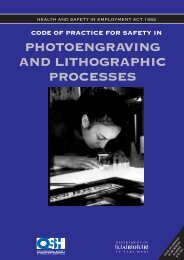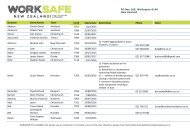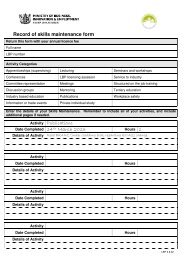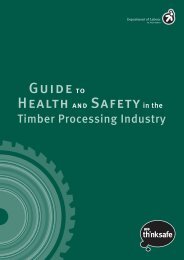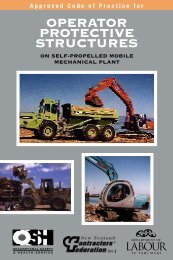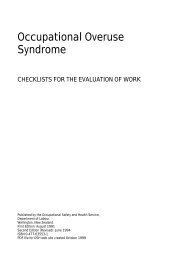Dental Therapy Practice - Best Practice ... - Business.govt.nz
Dental Therapy Practice - Best Practice ... - Business.govt.nz
Dental Therapy Practice - Best Practice ... - Business.govt.nz
- No tags were found...
Create successful ePaper yourself
Turn your PDF publications into a flip-book with our unique Google optimized e-Paper software.
Published by the Auckland Regional <strong>Dental</strong> Service,Waitemata District Health BoardAugust 2001ISBN 0-473-07844-9
ContentsACKNOWLEDGEMENTS ............................................................................................................... 7FOREWORD ................................................................................................................................ 7INTRODUCTION........................................................................................................................... 8STATEMENT OF INTENT .............................................................................................................. 91. HAZARD MANAGEMENT ........................................................................................................ 101.1 Hazards in the <strong>Dental</strong> Workplace .............................................................................. 101.1.1 Biological Hazards ................................................................................................. 111.1.2 Chemical Hazards.................................................................................................. 151.1.3 Physical Hazards ................................................................................................... 161.1.4 Environmental Hazards .......................................................................................... 171.1.5 Ergonomic Hazards................................................................................................ 181.1.6 Psycho-Social Hazards .......................................................................................... 192. EMERGENCIES ...................................................................................................................... 213. ACCIDENT REPORTING AND INVESTIGATION .......................................................................... 214. TRAINING AND EDUCATION ................................................................................................... 25APPENDICES1. Summary of the Health and Safety in Employment Act 1992 ....................................... 262. Blood and Body Fluid Accident Protocol ...................................................................... 29DENTAL THERAPY PRACTICE GUIDELINES
AcknowledgementsThe persons who compiled these guidelines were:Dora Smith Occupational Safety and Health ServiceJoyce Wilkinson Health WaikatoGail Tadema Health WaikatoNoeleen Evans <strong>Dental</strong> <strong>Therapy</strong> Programme(Wellington Polytechnic)Andrea Jarrold Auckland Regional <strong>Dental</strong> Service,Waitemata District Health BoardElizabeth Minson Auckland Regional <strong>Dental</strong> Service,Waitemata District Health BoardWe acknowledge the assistance that has been received from the:Occupational Safety and Health Service, Department of Labour;New Zealand <strong>Dental</strong> Association;Community and School <strong>Dental</strong> Services Forum;New Zealand <strong>Dental</strong> Therapists Association.ForewordSPECIAL ACKNOWLEDGEMENTto Medic <strong>Dental</strong>, a division of EBOS GROUP LTD. who have sponsoredthe printing of this document.The purpose of this document is to provide dental therapists andassistants, as well as their employers, with guidelines of best practice inoccupational safety and health.The initiative for this project came from an officer of the OccupationalSafety and Health Service who spent some time investigatingoccupational overuse in dental therapists working in Taranaki.Occupational overuse syndrome in dental therapy was recognised as aworkplace injury in the early 1990s. As there was no formaldocumentation covering the New Zealand dental workplace, theseguidelines will assist employers and employees in the future.DENTAL THERAPY PRACTICE GUIDELINES7
IntroductionThe Health and Safety in Employment Act 1992 (HSE Act) came intoforce on 1 April 1993 and reformed the legislation relating to theprevention of harm to employees while at work. It also strengthened theprovisions for ensuring that actions at work do not result in harm to otherpeople, including members of the public.The Occupational Safety and Health Service of the Department of Labour(OSH), administers the Health and Safety in Employment Act 1992, theHealth and Safety in Employment (Prescribed Matters) Regulations 1993and the Health and Safety in Employment Regulations 1995.The principal object of the HSE Act is to provide for the prevention ofharm to employees at work and, for the purpose of attaining this object, itpromotes excellence in health and safety management by employers andprescribes and imposes on employers, and others, duties in relation to theprevention of harm to employees.The HSE Act covers all workplace environments that place theresponsibility for health and safety right throughout the organisation, withresponsibility being shared by management and employees.A review of available literature identified clear links between reports ofpain and those tasks that involve ‘high precision work and sustained staticloading in the neck-shoulder region, combined with a flexed and rotatedcervical spine’. (Milerad, Ericson et al, 1991)Ergonomic assessments of dental therapists/assistants have found stronglinks between equipment and work practices resulting in gradual processinjuries. Repetitious hand movements result in cumulative traumadisorders such as tenosynovitis, carpal tunnel syndrome, tendonitis andbursitis. These are aggravated by certain hand and wrist positions,particularly in combination with forceful exertions.These guidelines clearly set out procedures to assist dental services indeveloping standards for hazard management, accident management,emergency procedures, training and supervision and the control ofcontractors. Ideally, this involves setting goals for health and safety,establishing formal operating plans and procedures, ensuringresponsibilities are understood and measuring performance againstobjectives.Emphasis is placed on the need for co-operation and communicationbetween employee and employer.8DENTAL THERAPY PRACTICE GUIDELINES
Statement of IntentA written statement of intent, as per example, should be at the forefront ofany health and safety protocol to state the employer’s commitment.This policy is the employer’s commitment and should be the same for alldepartments.This statement of intent should be divided into three sections:Section One: What the employer is going to do.Section Two: Who is responsible for managing policy.Section Three: Actions and inactions by employers not to harm.Example................................................................... is committed to the highestlevel of occupational health and safety and will:• Protect the health and safety of all employees, the public and allcontractors legally working on the premises.• Provide a safe workplace, safe equipment, proper materials andhave established and implemented a health and safetymanagement programme to ensure safe methods and safepractices are used at all times.• Optimise the management of resources available for theprovision of health services.• Comply with all health and safety legislative requirements.Everyone has a role in contributing to the health and safety programme inorder to provide the highest quality of service to our customers............................................................Chief Executive“Together the job is safer and more satisfying”Employers are encouraged to develop their own statement and/or policyto personalise it for their workplace.DENTAL THERAPY PRACTICE GUIDELINES9
1. Hazard ManagementManagement of hazards in the workplace comprises of the identification,assessment and control of hazards and the education and supervision ofemployees in respect of hazards.The duties of employers are to:• IDENTIFY all new and existing hazards by surveying the placeof work;• ASSESS the hazards to decide which are significant; and• CONTROL significant hazards by:- ELIMINATION — This is the first option and “allpracticable steps” must be taken to achieve this, e.g.substitution of a hazardous substance with a less harmful one.- ISOLATION — This is the second option applied whenelimination is not practicable, e.g. placing contaminatedsharps in a sharps container.- MINIMISATION — Where elimination or isolation cannotbe achieved, the employer must take all practicable steps tominimise the likelihood of harm from the hazard, e.g. usingcapsules instead of bulk mercury.Minimising the hazard is effected by:• Training employees in the nature of the hazard;• Provision and use of personal protective equipment;• Monitoring employees’ exposure to the hazard; and• Monitoring employees’ health relative to hazard exposureEvery effort must be made to isolate or eliminate hazards.1.1 HAZARDS IN THE DENTAL WORKPLACEHistorically, the management of cross infection, materials, chemicals andequipment has not been regulated and the hazards have been regarded asminimal. However, the HSE Act requires the employer to be responsiblefor the process of systematically identifying existing and potential hazardsin his/her practice, and then assessing whether they are significanthazards.Each employer shall provide a hazard identification checklist covering thehazards categorised below. A policy defining the principles of review must bedeveloped by the employer to ensure all dental clinics/workplaces have aminimum of one hazard identification check per year. <strong>Dental</strong> clinics/workplaces operating all year round shall have a minimum of two per year.10DENTAL THERAPY PRACTICE GUIDELINES
1. Biological 4. Environmental• Infection • Lighting• Waste• Noise2. Chemical • Ventilation• MSDS• Temperature• Storage 5. Ergonomic3. Physical 6. Psycho-Social• Equipment• Electricity• Light• RadiationHazard Identification ProcessThe most effective way of identifying existing hazards in the dentalworkplace is by examining specific areas of the dental practice and theactivities carried on in them.A static worksite, such as a dental practice, is well suited to a hazardidentification method of grouping hazards into common types, e.g.chemical, biological, electrical, and identifying them by surveying thedifferent areas of the site. The common hazards pertaining to a dentalpractice have already been identified but individual practices may havehazards not covered here.A Plan for Hazard Identification of a Clinic/<strong>Dental</strong> <strong>Practice</strong>1. Develop a hazard identification document.2. Divide checklist into categorised hazards.3. List all equipment, chemicals and processes in each.4. List specific hazards which may cause harm.Energy sources present may include:• noise• infection• fumes• radiation• electrical energy• physical effort of people.1.1.1 BIOLOGICAL HAZARDS(A) INFECTION(Refer to the code of practice on infection control as established by youremployer.)(a) Management of Health Care WasteEach provider shall develop a procedure for the storage and removal ofDENTAL THERAPY PRACTICE GUIDELINES11
hazardous waste that meets with the requirements of AS/NZS 3816:1998Management of clinical and related wastes.Health employers and managers of companies carrying medical wasteshould adhere to the New Zealand Transport Authority legislation for thetransporting of hazardous waste.(b) Exposure DeterminationIdentification of employees whose job classification determines:• all employees who have occupational exposure e.g. therapist,hygienist, chairside/dental assistant; or• employees who have little or no occupational exposure, e.g.office manager, secretary, etc.(c) Standard PrecautionsStandard precautions mean “a single standard for infection control shouldbe adopted for a practice and this should be utilised for every patient”.Obtain a comprehensive medical history from all patients at their firstvisit to the practice and update and review this at subsequent visits.Carriers of infections, such as HBV and HIV, may be unaware of theirstatus or withhold information. It is important, therefore, that all humanblood and body fluids be treated as if contaminated with HBV, HIV andother bloodborne pathogens.(d) Work <strong>Practice</strong> ControlsWork practice controls are aimed at reducing exposure to an infectiousagent by either removing the hazard or isolating the health care providerfrom the hazard.Sharps: Contaminated needles or other sharps should not be bent,recapped or removed, except by means of a mechanical device or aonehanded technique. Immediately, or as soon as possible after use,sharps should be placed into a secure, puncture-resistant container whichis leak-proof and labelled with the biohazard symbol.All sharps containers are to be disposed of by professional medical wasteremoval systems.Work practice controls are aimed at reducing the risk of exposure to aninfectious agent by altering the manner in which a task is performed.Handwashing: Hands should be washed with soap and water and driedthoroughly immediately before putting gloves on and immediately afterremoval of gloves.Personal Habits and Eating: Eating, drinking, smoking, application ofcosmetics or handling of contact lenses should not be permitted in workareas where there is a reasonable likelihood of exposure.Food Storage: Food and drink must not be stored in refrigerators,cabinets or on counters where blood or other potentially infectiousmaterials may be present.12DENTAL THERAPY PRACTICE GUIDELINES
Minimising Exposure: Procedures involving blood or other potentiallyinfected substances must be performed in a manner which reduces spraying,splattering or generation of droplets, e.g. use of high-volume evacuationwhich is externally vented; use of rubber dam; or limit contamination byavoidance of contact with unnecessary items.(e) Personal Protective Equipment (PPE)The employer (at the employers’ expense) must provide employees withsuitable and appropriate PPE. PPE is designated as suitable only if it servesto prevent the penetration of blood or other potentially infectious materialthrough to the employee’s clothes, skin, eyes or mouth under normalconditions of use and for the duration of time for which the protectiveequipment will be used.It is the responsibility of the employer to ensure that all employees useappropriate PPE.Have appropriate PPE readily available at each worksite.Wear protective clothing in situations of occupational exposure; the type andfeatures of clothing will depend upon the task and degree of exposureanticipated.Gloves— ensure disposable gloves do not restrict hand movement.Provide patients with protective equipment to wear during procedures thatmay result in physical or chemical injury or risk of infection. This includesprotective eyewear, lead aprons for dental radiographs.Protective clothing should not be worn outside the surgery area.(f) Blood/Body Fluid OccurrencesThe following situations are regarded as blood accidents:• Needle stick from a contaminated needle.• Another person’s blood contaminating an open wound.• Contact of another person’s blood with eyes or mucousmembranes.• A bite by another person that breaks the skin.• Skin broken by an instrument or bur.It is important to develop and follow approved safety procedures for thecontainment and clean up of blood. Employers shall provide appropriatemeasures, e.g. Presept Granules, and document the procedures in a clinicalpractice protocol.Training should also be provided for all new staff members at orientation tothe service.Needlestick InjuriesNeedlestick injuries pose the greatest risk for cross infection.• The needle cover must be used at all times when recappingneedles.• Needlestick injuries or any blood accidents must be reported within24 hours of the occurrence.See Appendix 2.DENTAL THERAPY PRACTICE GUIDELINES 13
Eye CareIf debris lodges in the eye or an eye splash occurs, immediately wash theeye with copious amounts of water. If the eye does not clear, medicalassistance should be sought and the injury reported to your appropriateperson.Eye baths and saline solution should be readily available.The manufacturers of curing lights (Elipar or similar) issue awarning that protective shields must be used at all times whenthe light is in use to protect the operator from damage to theretina of the eyes.VaccinationAll dental therapists are subject to occupational exposure and should beoffered vaccination against Hepatitis B virus. Vaccination of employeesshould be available at the employer’s expense and should be initiatedbefore assignments to tasks that may result in exposure. Vaccination is notnecessary if the employee has previously received the full course of HB Vvaccination, if antibody testing reveals immunity, or if the vaccine iscontraindicated for medical reasons.Employers are encouraged to monitor the Hepatitis B status of staff andthe results shall be shared between the employee and employer. Theemployer may be represented by the occupational health department ofthe organisation.Employers shall develop a policy and procedure for addressing employeeswho may decline vaccination at the time of recruitment.If an employee declines vaccination for any reason, then a written reportfrom the employee’s medical practitioner should be requested prior toappointment and kept on file. A declination form is to be completed bythe employee and filed on their personal file.DecontaminationWear well-fitting disposable gloves for hand protection when cleaningand disinfecting surfaces or items contaminated with blood or otherpotentially infected materials.Thoroughly clean all equipment and contaminated surfaces according toinfection control procedure.Disposal of contaminated waste — refer to A(a) on page 9.Training in Infection ControlThe employer is responsible for providing adequate training to allemployees on standard precautions against cross infection to ensurenational standards are met.The employer is responsible for assessing the level of knowledge andability of individual employees following training.14DENTAL THERAPY PRACTICE GUIDELINES
A record of training sessions must be documented date, content and nameof trainer, signed by the employee and the trainer.Evaluate effectiveness. This ensures a quality approach to training.(B) WASTE HAZARDSSurgery waste requires special care and different waste requires specialhandling• Ensure employees are not exposed to hazards arising fromdisposal of material.• Identify hazards in the workplace and instruct employers andemployees on personal protection.• Develop procedures for dealing with emergencies, e.g. mercuryspill.• Have a schedule for waste management and a training schedule.• Be familiar with responsibilities under the ResourceManagement Act 1993 and local body regulations.• Develop and implement waste disposal procedures to complywith your company and the local body regulations.Refer to 1.1.1 Biological Hazards.1.1.2 CHEMICAL HAZARDSChemical hazards are of major concern in a dental practice. Knowledge ofchemicals that present a hazard in their handling and use is essential forall staff.A list of chemicals and materials that are potentially hazardous shall beidentified. It should not be regarded as definitive and from time to timeadditions and deletions will be required. Different practices will havedifferent lists.Each practice should maintain an up-to-date list of !chemicals on thepremises along with the appropriate Material Safety Data Sheets.Training• All employees will receive training in the use and safe handlingof hazardous materials before they are required to handles thesematerials. This training will be reviewed and updated whereappropriate. All such training will be recorded.• All employees will be trained to emphasise the importance ofdrugs being stored in a secure manner to prevent unlawfulaccess.External Contractors• Any contractors coming into the practice will be advised of anypossible likelihood of exposure to hazardous material orsituations, and how to deal with this should it arise.• Also the contractor will be questioned regarding the possibilityof introducing any new hazards into the workplace and how hewill control these during the time of the contract.DENTAL THERAPY PRACTICE GUIDELINES15
(a) Material Safety Data SheetsMaterial Safety Data Sheets (MSDS) contain information on productshazardous to health, such as storage and safe handling requirements,precautions for use, first-aid procedures, and physical properties.NZ manufacturers or importers are required to make MSDS available inany place of work where a product hazardous to health is used. Theemployer shall ensure that a current MSDS or other written informationof equivalent quality, such as a Product Safety card, is accessible toemployees working with or who are exposed to chemicals in the course oftheir duties.The MSDS register must be reviewed on an annual basis and documentedthat this has been completed.(b) Storage of Chemicals• List all hazardous materials used in the practice in a hazardouschemicals register and update as necessary.• Ensure all containers have labels to show chemical identity andappropriate hazard wanting. Where possible include first-aidinformation.• Care must be taken that incompatible chemicals are not storedtogether. Chemical compatibility information is included on theMSDS.• Hazard potential depends on the amount of exposure andindividual variability. In most dental practices amounts ofchemicals are small and risks are correspondingly small.• All chemicals used in a dental practice must be stored in amanner that prevents accidental or unlawful access, e.g. secure/lockable cupboard or filing cabinet.Refer to the Approved Code of <strong>Practice</strong> for the Management ofSubstances Hazardous to Health, published by OSH.c) Materials/Drugs• All materials/drugs used in a dental practice must be stored in amanner that prevents accidental or unlawful access, e.g. secure/lockable cupboard or filing cabinet.• In storage, take special precautions to avoid child access.• Follow your employer’s protocol for disposal of expired andobsolete drugs.• Keys to any lockable cupboards shall be kept in a safe/secureplace and available to dental staff only.1.1.3 PHYSICAL HAZARDS(A) RADIATIONThe Radiation Protection Act (1965) and its Regulations (1982) permitsthe use of an X-ray machine by persons acting under the supervision orinstruction of a person who is suitably qualified and suitably licensed.16DENTAL THERAPY PRACTICE GUIDELINES
Each employer shall develop a code of practice for dental radiography,and ensure staff are trained in the safe use of dental X-ray machines andassociated chemicals.Refer to Chemical Hazards 1.1.2 for managing X-ray developingchemicals.(B) EQUIPMENTEmployers shall:• ensure that equipment used is ergonomically sound and that allstaff are trained to use equipment safely;• develop hazard checklist of all equipment in use;• assess equipment for hazards; and• document assessment results.(C) ELECTRICALAll practices will comply with the requirements of New Zealand StandardNZECP 12:1993 for electrical installations.See also NZS 3 760:2000 In-service safety inspection and testing ofelectrical equipment.All equipment shall be checked and labelled as having had an annualsafety check.Employers shall ensure that procedures are developed and staff trained.Electrical Verification Dossier ProcedureThe obligations under the NZECP: 12 are to:• visually examine sockets and outlet switches monthly;• test earth leakage circuit breakers and reset monthly;• test earth leakage circuit breakers for sensitivity, performanceand speed using approved testing apparatus every six months;• visually examine and measure the continuity of earthingfacilities every twelve months; and• maintain and make available to the testing authority, averification dossier of test results.Follow accepted procedures to avoid and handle emergencies:• Disconnect electricity before investigating faults.• Do not overload outlets and plugs — be careful with plugboards, they can overload.• Use earth leakage protection devices.1.1.4 ENVIRONMENTAL HAZARDS(A) VENTILATIONAll practices MUST have adequate ventilation to remove hazardousvapours and to provide a supply of fresh air.DENTAL THERAPY PRACTICE GUIDELINES17
(B) TEMPERATUREEmployers are responsible to ensure that comfortable atmosphericconditions in the workplace are maintained.Staff working in a comfortable environment perform their work moreefficiently and are less likely to make mistakes that could result in anaccident.(C) NOISENoise levels should not exceed that recommended in the Approved Codeof <strong>Practice</strong> for the Management of Noise in the Workplace, published byOSH.Refer to the Health and Safety in Employment Regulations 1995,regulation 11.The maintenance of equipment assists in reducing noise emissionreaching damage risk criteria.(D) LIGHTINGIf fluorescent lighting is used, a diffuser must cover them and doubletubes should always be used.Information on this is also available in the Approved Code of <strong>Practice</strong> forthe Safe Use of Visual Display Units, published by OSH.Refer to AS/NZS 1680.2.5:1997 Interior lighting for hospital and medicaltasks.1.1.5 ERGONOMIC HAZARDSEmployers have a responsibility to ensure postural stress on staff isminimised. Operating situations and working at VDU workstations canpose a risk.Properly specified and designed hand tools will reduce injuries andimprove performance capabilityThe shape and size of a hand tool have a direct effect on both a person’sperformance capability (especially grip strength) and biomechanical stresson the upper extremity.(A) OPERATING POSTUREThe demands of high precision work and sustained static loading in theneckshoulder region, combined with a flexed and rotated cervical spine,can result in an increased level of musculoskeletal disorders.Employers are responsible for ensuring the personal health and safety oftheir employees in the work environment.<strong>Best</strong> practice operating guidelines shall be developed and given to staff atorientation.<strong>Best</strong> practice checklist forms shall also be developed to assist in themonitoring process.18DENTAL THERAPY PRACTICE GUIDELINES
Postural Hazards:• Poorly adjusted equipment• Poorly planned work stations• Lack of mini and maxi pauses• Lack of workflow planning.Training:• Students to attend a dental therapy programme• Orientation to workforce• Annual injury prevention module• Mandatory training on all new equipment.Monitoring:• <strong>Best</strong> practice review• Peer review• Health and safety audits.Refer to How to Use Your VDU Safely, published by OSH.(B) PURCHASING OF EQUIPMENTEmployers have a responsibility to source ergonomically-designedequipment that should be trialed in the workplace prior to purchase.All equipment purchased shall meet OSH specifications if applicable, e.g.office furniture.1.1.6 PSYCHO-SOCIAL HAZARDSIt must be recognised that there are psycho-social hazards that couldaffect the health of dental workers. Employers must develop proceduresto manage these situations.The list below (which is not definitive) identifies some examples ofpsycho-social hazards:• workload• no control of workload• shifting clinics• working alone• working with others• drugs/alcohol• parental pressure• home and family• excessive stress• lack of sense of belonging.To minimise psycho-social hazards the employer should ensure:• that all practical steps are taken to eliminate or reduce provenhazards;• that employer assistance programmes or similar services are beavailable;DENTAL THERAPY PRACTICE GUIDELINES19
• they will continue to develop new ways of working that reducethe impact of psycho-social hazards;• a safe environment for staff to report these hazards;• staff must be assured they will be listened to; and• staff have access to the schools’ crisis management plans.20DENTAL THERAPY PRACTICE GUIDELINES
2. EmergenciesPossible emergencies include:PROCEDURES• fire• flood• earthquake• security breach• chemical spill (including mercury)• serious injury/medical emergency.Section 6 of the Health and Safety in Employment Act requires thedevelopment of emergency procedures, and section 14 requiresemployees to be involved in their development.Employers have a responsibility to ensure that staff are familiar with theprocedure for emergency evacuation of the workplace.School emergency procedures shall be clearly displayed in school clinicsand staff will be familiar with actions required and adhere to all schoolpolicies, regarding these procedures.3. Accident Recording, Reporting andInvestigationSection 25 of the Health and Safety in Employment Act requiresemployers to:• Record in an accident register all events that harmed or mighthave harmed (this includes near-misses) employees or otherpeople in the place of work.• Notify OSH as soon as possible of events resulting in seriousharm to employees and provide OSH with a written reportwithin 7 days on the prescribed form.It is recommended that the local OSH office phone number be readilyaccessible.Please see the accident reporting and investigation flow chart on the nextpage.DENTAL THERAPY PRACTICE GUIDELINES21
ACCIDENT REPORTING AND INVESTIGATIONFLOWCHARTACCIDENT/INCIDENT(SERIOUS HARM)Time scaleIf serious harm, do notdisturb the accident sceneREPORT TOManager/delegated authority/person in chargeImmediately followingaccidentlncidentImmediately notify manageror occupational health• EMPLOYEES: Treatment (first aid or other)• RC MANAGER: or nominated person fills in detailsin accident registerWithin 24 hoursImmediately notify nearestOSH (Department of Labour)office• Occ health initiates accident investigation.• Investigation team uses accident investigationform to determine if accident arose from orwas caused by a significant hazard.7 daysReport to OSH on prescribedform within 7 daysACCIDENT REPORTAppropriate senior manager for approvaland to instigate action.Report completedwithin 24 hoursCommunication/feedback on accidentfindings to all appropriate staff.As soon as practicable• Managers/delegated authority: follow-upand review.• Management analysis of accidents — monthly.Also review of findings/recommendations,etc.in safety and health meetingsACTION COMPLETE22DENTAL THERAPY PRACTICE GUIDELINES
SERIOUS HARM - Schedule 1(1) Serious harm is any of the following conditions that amount to orresult in permanent loss of bodily function, or temporary severe loss ofbodily function: respiratory disease, noise-induced hearing loss,neurological disease, cancer, dermatological disease, communicabledisease, musculoskeletal disease, illness caused by exposure to infectedmaterial, decompression sickness, poisoning, vision impairment, chemicalor hot-metal bum of eye, penetrating wound of eye, bone fracture,laceration, crushing.(2) Amputation of body part.(3) Bums requiring referral to a specialist registered medical practitioneror specialist outpatient clinic.(4) Loss of consciousness from lack of oxygen.(5) Loss of consciousness, or acute illness requiring treatment by amedical practitioner, from absorption, inhalation, or ingestion of anysubstance.(6) Any harm that causes the person harmed to be hospitalised for aperiod of 48 hours or more, commencing within 7 days of the harm’soccurrence.Definition of temporary severe loss of bodily functionThis term is defined as follows:Overall, the judgement on whether an employee has suffered temporaryloss of bodily function is determined by whether there has been an actualloss of bodily function, and this will involve the employer (orrepresentative) making a judgementThose who need to determine if temporary loss has occurred will need toanswer the following questions:(a) Is the employee suffering from pain or health impairment which issignificantly more than discomfort?(b) Is the pain or health impairment severe enough to prevent anemployee using part of the body, i.e. movement prohibited by pain,respiratory distress, etc?(c) Is the employee’s condition likely to be temporary?If the answer to these questions is “yes”, then OSH should be notified interms of section 25 of the Act.No interference at accident scene(1) Where a person is seriously harmed while at work, no person shall,unless authorised to do so by an inspector, remove or in any way interferewith or disturb any wreckage, article or thing related to the accident/incident except to the extent necessary -(a) To save the life of, prevent harm to, or relieve the suffering of, anyperson; or(b) To maintain the access of the general public to an essential service orutility; orDENTAL THERAPY PRACTICE GUIDELINES23
4. Training and EducationINTRODUCTIONGood injury prevention requires the employer to undertake training,education and supervision of employees to ensure that they can undertaketheir work safely for both themselves and for others involved in theirwork (i.e. clients) and meets the requirements of the Act.TRAINING SHOULD INCLUDE• Emergency procedures;• Cross infection control procedures;• Working with hazardous substances; and• <strong>Best</strong> practice.Such training should be provided to all employees at the commencementof employment and regularly updated.Training should be presented in such a manner that it is clearlyunderstood by all staff.Include measures to identify and protect the employee from identifiedhazards in a dental practice, e.g. use of personal protective equipment.Also measures should be taken for the protection of clients.Design a programme, or use an existing one, for use within a practice asper company procedures.TRAINING RECORDSTraining records should be maintained to prove compliance with theHealth and Safety in Employment Act.Include the following in training records:• Dates of training session;• Contents/summary of the session;• The name and qualification of the person conducting the course;• The names of those attending the course; and• Evaluate effectiveness, e.g. multi-choice questions and trainee’scomments.DENTAL THERAPY PRACTICE GUIDELINES25
Appendix 1: Summary of the Health and Safety inEmployment Act 1992OBJECT OF THE ACTThe principal object of the Health and Safety in Employment Act 1992 isto prevent harm to employees at work. To do this it imposes duties onemployers, employees, principals and others, and promotes excellenthealth and safety management by employers. It also provides for themaking of regulations and codes of practice.EMPLOYERS’ DUTIESHAZARD MANAGEMENTEmployers have the most duties to perform to ensure the health and safetyof employees at work. Employers have a general duty to take allpracticable steps to ensure the safety of employees. In particular, they arerequired to take all practicable steps to:• Provide and maintain a safe working environment;• Provide and maintain facilities for the safety and health ofemployees at work;• Ensure that machinery and equipment is safe for employees;• Ensure that working arrangements are not hazardous toemployees; and• Provide procedures to deal with emergencies that may arisewhile employees are at work.Taking “all practicable steps” means what can reasonably be done toachieve the result in the circumstances, taking into account:• The severity of any injury or harm to health that may occur;• The degree of risk or probability of that injury or harmoccurring;• How much is known about the hazard and the ways ofeliminating, minimising or isolating it; and• The availability, effectiveness and cost of the possiblesafeguards.Employers must have an effective method to identify and regularly reviewhazards in the place of work (existing, new and potential). They mustdetermine whether the identified hazards are significant hazards andrequire further action.“Significant hazard” means a hazard that is an actual or potential cause orsource of:• Serious harm; or26DENTAL THERAPY PRACTICE GUIDELINES
• Harm (being more than trivial) where the severity of effects ona person depends (entirely or among other things) on the extentor frequency of the person’s exposure to the hazard; or• Harm that does not usually occur, or usually is not easilydetectable, until a significant time after the exposure to thehazard.Where the hazard us significant, the HSE Act sets out the steps employersmust take:• Where practicable, the hazard must be eliminated.• If elimination is not practicable, the hazard must be isolated.• If it is impracticable to eliminate or isolate the hazard, theemployer must minimise the likelihood of employees beingharmed by the hazard.Where the hazard has not been eliminated or isolated, employers must:• Ensure that protective equipment is provided, accessible andused;• Monitor employees’ exposure to the hazard;• Seek the consent of employees to monitor their health; and• With their informed consent, monitor employees’ health.INFORMATION FOR EMPLOYEESBefore employees begin work, they must be informed by their employerof:• Hazards employees may be exposed to while at work;• Hazards employees may create which could harm people;• How to minimise the likelihood of these hazards becoming asource of harm to themselves and others; and• The location of safety equipment.EMPLOYERS TO INVOLVE EMPLOYEESEmployers need to ensure that all employees have the opportunity to befully involved in the development of procedures for the purpose ofidentifying and controlling significant hazards, or dealing with or reactingto emergencies and imminent dangers.TRAINING OF EMPLOYEESEmployers must ensure employees are either sufficiently experienced todo their work safely or are supervised by an experienced person. Inaddition, employees must be adequately trained in the safe use of allplant, substances and protective clothing and protective equipment thatthe employee may be required to use or handle.DENTAL THERAPY PRACTICE GUIDELINES27
SAFETY OF PEOPLE WHO ARE NOT EMPLOYEESEmployers also have a general duty towards persons who are notemployees.Employers must take all practicable steps to ensure that employees do notharm any other person while at work, including members of the public orvisitors to the place of work.EMPLOYEES AND SELF-EMPLOYED PERSONS’ DUTIESEmployees and self-employed persons have a responsibility for their ownhealth and safety while at work. They must also ensure that their ownactions do not harm anyone else.However, these responsibilities do not detract from the employer’sresponsibilities.ACCIDENTS AND SERIOUS HARM (RECORDING AND NOTIFICATION)The HSE Act requires employers to keep a register of work-relatedaccidents and serious harm. This includes every accident that harmed (ormight have harmed):• Any employee at work; and• Any person in a place of work under the employer’s control.Employers are also required to investigate all accidents and near-missincidents to determine whether they were caused by or arose from asignificant hazard. Employers are required to notify serious harm thatoccurs to employees while at work to the Secretary of Labour (in practice,the nearest OSH office) as soon as possible. In addition, thecircumstances of the accident must be notified in the form prescribedwithin 7 days. (Suitable forms for notification are available from OSHoffices and selected stationers.)If a person suffers serious harm, the scene of the accident must not bedisturbed unless to:• Save life or prevent suffering;• Maintain public access for essential services, e.g. electricity, gas; or• Prevent serious damage or loss of property.The OSH office will advise whether it wishes to investigate the accidentand what action may be taken in the meantime.28DENTAL THERAPY PRACTICE GUIDELINES
Appendix 2: Blood/Body Fluid/Accident Protocol(If not already available from your employer)1. THE WOUND• Wash under cold running water• Apply gentle pressure to encourage bleeding• Cover with waterproof tape.2. COUNSEL HEALTH CARE WORKER AND PATIENT3. SEND FOR BLOOD SCREENINGExplain that an accident has occurred and for the protection of everyoneworking and attending the practice it is important to eliminate thepossibility, however remote, of transmission of any known infectiousdisease.Health Care Worker: Baseline serology HIV, Hepatitis B and CIf hepatitis vaccinated, assess anti-HB’s levelRepeat blood tests in 3, 6 and 12 months’ time4. RECORDClient (if agreeable): Screen for HIV, hepatitis B and C.Enter details of injury in the accident/incident register. (Immediate actiontaken and long-term follow-up.)5. CLIENT TESTS POSITIVE/REFUSES TESTING/UNKNOWN6. INFORM ACCConsider prophylactic treatment for hepatitis B and C within 5 to 7 days.NOTE: Prophylactic use of ATZ for HIV must be commenced with 2 to 4hours of exposure, but is of unproved value and must not be used as amatter of routine.If appropriate, seroconversion occurs.If in doubt, contact a senior dental surgeon at your nearest hospital oralhealth unit or, if unavailable, an infectious diseases officer.THE IMPORTANCE OF AVOIDING ACCIDENTS WITHINFECTED MATERIAL CANNOT BE OVEREMPHASISED!DENTAL THERAPY PRACTICE GUIDELINES29


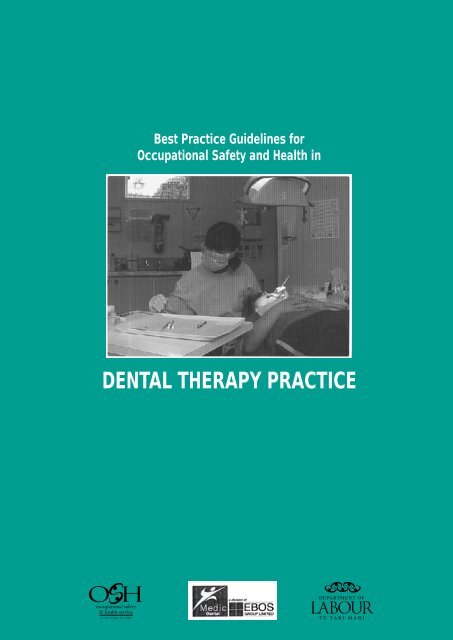

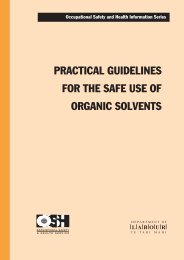
![Task analysis worksheet [161 KB PDF] - Business.govt.nz](https://img.yumpu.com/51400981/1/190x135/task-analysis-worksheet-161-kb-pdf-businessgovtnz.jpg?quality=85)

